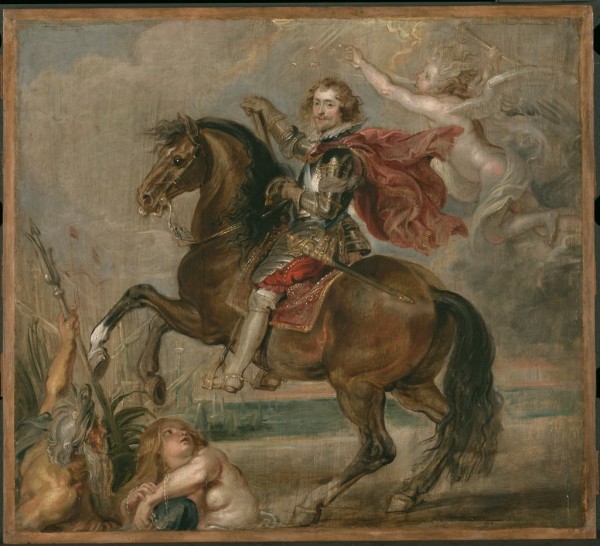The Extraordinary Rise of George Villiers
Villiers’s status as Royal favourite gave him great political power and influence. Maintaining the favour of two successive kings is possibly the most impressive of Villiers’s many achievements.

Equestrian Portrait of the Duke of Buckingham by Peter Paul Rubens
1625, Oil on panel
Kimbell Art Museum, Fort Worth, Texas AP 1976.08
This portrait captures the elegance and swagger that captivated Buckingham’s admirers—and inspired Alexander Dumas’ romantic depiction of him in The Three Musketeers. Portrayed as Lord High Admiral of the Navy, the Duke lifts his baton as his horse rears on command. Beneath him, the sea god Neptune and overhead, a winged allegory of Fame signals victory with a trumpet in hand. This vision of victory did not translate to the reality of Villiers’s naval career.
Villiers met the artist Peter Paul Rubens during a visit to Paris in 1625. He commissioned this grand equestrian portrait of himself from Rubens at a cost of £500 (the equivalent of about £120,000 today). This version was the sketch for that work; the original was destroyed in a fire in 1949.
Privately Rubens noted Buckingham’s “arrogance and caprice” and predicted that he was “heading for the precipice” and this portrait conveys his sense of self-importance.

The position of favourite was one which brought great wealth, but also great risk. Villiers was unpopular with rivals for the King’s affection and had many political enemies who resented his access to and influence over the monarch. Villiers‘s position meant that many other noblemen relied on his patronage to advance their careers. He was swift and ruthless at removing others from positions of power when they threatened his agenda or that of the monarch.
George also befriended James’s son, the future King Charles I. Their friendship grew on their unsuccessful mission to Madrid to progress Charles’s proposed marriage to a Spanish princess.
August 1614 First meets King James I at Apethorpe in Northamptonshire
23 April 1615 Knighted by James I on St George’s Day
4 January 1616 Appointed Master of the Horse
April 1616 Appointed to the Order of the Garter
27 August 1616 Made Baron Whaddon and Viscount Villiers
6 January 1617 Created Earl of Buckingham
4 February 1617 Sworn in as member of Privy Council
1 January 1618 Made Marquis of Buckingham
January 1619 Appointed Lord Admiral of the Fleet
16 May 1620 Marries Katherine Manners, daughter of the Earl of Rutland
28 March 1622 Katherine Villiers gives birth to a daughter Mary, nicknamed ‘Mall’
1623 Accompanies Prince (later King) Charles to Madrid
1623 Made 1st Duke of Buckingham while in Madrid. He was the first non-royal to become a duke for almost 100 years
1625 Death of King James I and accession of King Charles I
30 January 1628 Katherine Villiers gives birth to a male heir, also named George
22 August 1628 Villiers murdered in Portsmouth by John Felton
